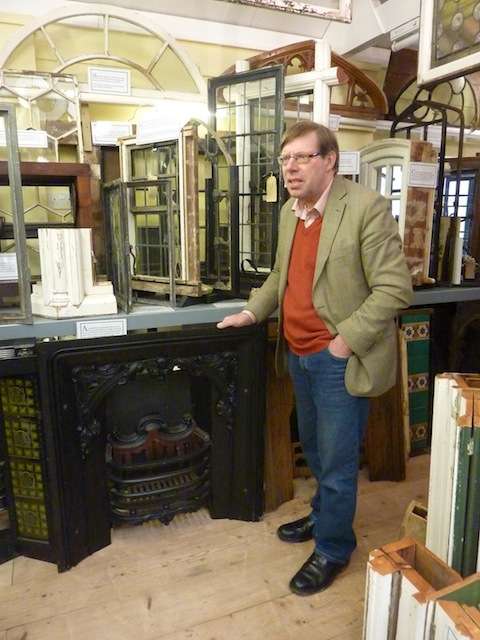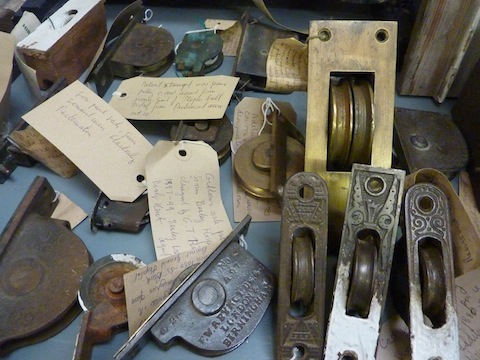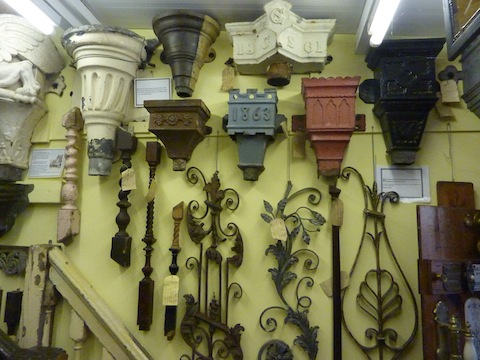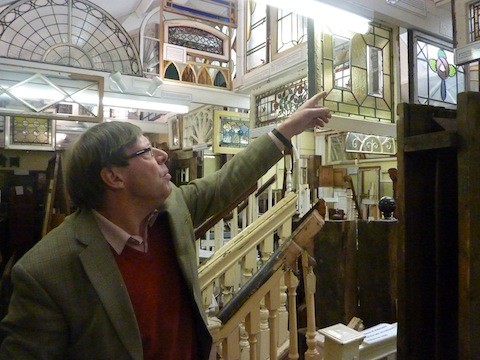 Abraham Lincoln
If given the truth, the people can be depended upon to meet any national crisis...
Abraham Lincoln
If given the truth, the people can be depended upon to meet any national crisis...
 Guildford news...
for Guildford people, brought to you by Guildford reporters - Guildford's own news service
Guildford news...
for Guildford people, brought to you by Guildford reporters - Guildford's own news service
Brooking’s Architectural Rescue – First Of A New Series
Published on: 17 Dec, 2012
Updated on: 17 Dec, 2012
Introducing the first in a series of articles by Charles Brooking on buildings in the Guildford area and their architectural detail.
For many years Charles Brooking has rescued architectural features from all kinds of properties – from national landmark buildings to the humble terrace house and country estates to vernacular cottages. His passion for collecting these items started at the end of the 1950s when he was a small child. Today his collection amounts to many thousands of items and is known as the The Brooking Collection of Architectural Detail. It is the only major national collection of its kind in the UK.
Here Charles explains how he became interested in architectural detail and then writes about the latest developments regarding his important collection, that is used as a teaching resource by conservation professionals, schools, architectural students, designers, crafts apprentices and private individuals.
My long association and fascination with Guildford buildings began in 1957 when my mother drove us over from South Cheam, where we lived, to visit my father, who had just undergone an operation at the (old) Royal Surrey County Hospital in Farnham Road.
My father then worked as the financial director for the Kenwood manufacturing company in Hipley Street, Old Woking. He travelled the world with Ken Wood during the late 1950s and early 60s promoting the now famous iconic food mixer.
I was fascinated by the old Royal Surrey County Hospital building and the many interesting antiques shops and old buildings in the town. It was during one of these trips that I spotted my first Guildford demolition site, which was the earliest part of the old Surrey Militia barracks site at the bottom of North Street – a row of 1790s terraced houses that had just been demolished. From there I retrieved one or two small items of interest.
Our family moved to Guildford in the summer of 1959 to a large unmodernised house in White Lane. The workmen presented me with the original servant bell indicator board, which I believe was made by Bowden & Higlett of Guildford.
My passion for historic building details was ignited. It was a case of being in the right place at the right time. Guildford in 1959 was at the beginning of a major period of change. Many fine buildings in the town were swept away during the years circa 1957-1985.

House numbers, finger plates, bells and door handles are some of the smaller items in Charles’ collection.
Buildings dating from the 17th century or earlier to fine Victorian/Edwardian houses were bulldozed. This, combined with my new passion for historic buildings, led to the creation of what is now nationally known as The Brooking Collection of Architectural Detail.
From the early 1960s, throughout the most intense period of redevelopment, I was fortunate enough to be able to preserve fine architectural elements from a wide cross-section of rich and varied building types in the town, ranging from 18th-century mansions to public buildings and untouched early 19th-century artisan cottages.
In 1966, with help and inspiration from my maths tutor, Edward Wyer, I decided to establish a new form of museum study collection embracing the features that make up the rich tapestry of our built heritage over the last 500 years, such as doors, windows, staircases, fire-grates, stained glass and ironmongery.
Initially, with help from both my parents, I visited most of Guildford’s now lost buildings before and during their demolition, photographing many in their last throes.
In a new series of features for The Guildford Dragon News I will illustrate some of these fine buildings so sadly swept away, which has turned a market town of character and great charm into what is so often described as a fine town blighted badly by architecture of the 1960s and 70s.
The Brooking Collection is about to embark on an exciting new chapter. For the last 25 years it has been used as a major teaching resource, both locally and at the University of Greenwich, aimed at both architects, historic building professionals, designers, students and the general public.
Owing to storage issues driven by the department’s move to a new site, the museum artefacts have been relocated from Greenwich to our trust’s new store in Surrey. The future aim of the interim trustees is to establish The Brooking Collection as part of a national Centre of Excellence for all those involved in the care and conservation of historic buildings, preferably in the London and Surrey area.
English Heritage has just commissioned the first of a series of books based on The Brooking Collection. This volume will concentrate on all forms of Georgian windows and will be aimed principally at owners of different types of buildings of this date. It will address the many questions we constantly receive about historic building details and act as a guide to those seeking advice on the correct repair and reinstatement of this important architectural element.
I owe much to Guildford. Its rich cross-section of building types has provided me with a valuable background in which to learn and develop an appreciation for the glories of this country’s architectural heritage. It provided a valuable starting point, both in terms of architectural appreciation and the ‘rescue’ of building features, which I now undertake regularly on a national basis. The features I have preserved from Guildford’s lost buildings will form part of a unique resource for scholars into the future.
The first of this series will highlight the recently-demolished Clavadel Hotel – a building of no great architectural significance, but an interesting example of late-Victorian domestic architecture of its type, and a venue that will hold many memories for people down the years.
If you are having improvements or renovation work done to your home (large or small) and the builders are rapidly filling a skip with old fixtures and fittings , Charles may well be interested in salvaging some of the items, particularly widow frames. If so, give him a call on 01483 274203. He may also be able to help you with examples of original fittings that your house would have had.
For more details about The Brooking Collection of Architectural Detail click here to see website.
Responses to Brooking’s Architectural Rescue – First Of A New Series
Leave a Comment Cancel replyPlease see our comments policy. All comments are moderated and may take time to appear.

"Found any?" - "Nope, it all looks green to me!" (See Opinion: The Future is Congested, the Future is Grey)
www.abbotshospital.org/news/">





Recent Articles
- Latest Evidence in Sara Sharif Trial
- Ash’s New Road Bridge Is Named – and November 23rd Is Opening Day
- Class A in Underwear Leads to Jail Sentence
- Historical Almshouse Charity Celebrates Guildford in Bloom Victory
- Notice: Shalford Renewable Showcase – November 16
- Firework Fiesta: Guildford Lions Club Announces Extra Attractions
- Come and Meet the Flower Fairies at Watts Gallery
- Updated: Royal Mail Public Counter in Woodbridge Meadows to Close, Says Staff Member
- Letter: New Developments Should Benefit Local People
- Open Letter to Jeremy Hunt, MP: Ash’s Healthcare Concerns


Recent Comments
- Paul Spooner on Ash’s New Road Bridge Is Named – and November 23rd Is Opening Day
- Harry Eve on Opinion: The Future is Congested, the Future is Grey
- Nigel Keane on Letter: New Developments Should Benefit Local People
- Nathan Cassidy on Updated: Royal Mail Public Counter in Woodbridge Meadows to Close, Says Staff Member
- T Saunders on Opinion: The Future is Congested, the Future is Grey
- Jim Allen on Updated: Royal Mail Public Counter in Woodbridge Meadows to Close, Says Staff Member
Search in Site
Media Gallery
Dragon Interview: Local Artist Leaves Her Mark At One of England’s Most Historic Buildings
January 21, 2023 / No Comment / Read MoreDragon Interview: Lib Dem Planning Chair: ‘Current Policy Doesn’t Work for Local People’
January 19, 2023 / No Comment / Read MoreA3 Tunnel in Guildford ‘Necessary’ for New Homes, Says Guildford’s MP
January 10, 2023 / No Comment / Read More‘Madness’ for London Road Scheme to Go Ahead Against ‘Huge Opposition’, Says SCC Leader
January 6, 2023 / No Comment / Read MoreCouncillor’s Son Starts Campaign for More Consultation on North Street Plan
December 30, 2022 / No Comment / Read MoreCounty Council Climbs Down Over London Road Works – Further ‘Engagement’ Period Announced
December 14, 2022 / No Comment / Read MoreDragon Interview: GBC Reaction to the Government’s Expected Decision to Relax Housing Targets
December 7, 2022 / No Comment / Read MoreHow Can Our Town Centre Businesses Recover? Watch the Shop Front Debate
May 18, 2020 / No Comment / Read More












Chris Townsend
December 21, 2012 at 8:05 am
I look forward to the new series by Charles. I note that he says he was fascinated, as a child, by the old Royal Surrey County Hospital building. There was once a memorial there to a Capt. Percy Levick, R.A.M.C., formerly a Guildford doctor, and hon. M.O. to the hospital. He was accidentally killed in France in 1918, and his fellow officers raised funds for the memorial. The hospital Archivist told me (in the 1980s?) that he remembered the plaque, but it had disappeared at the time of a refurbishment. Does anyone know what happened to the plaque?